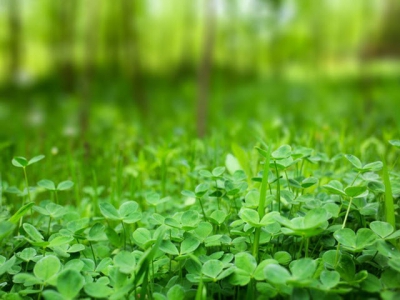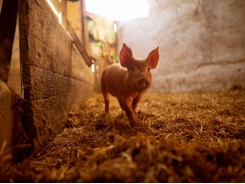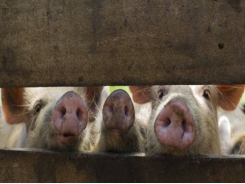Putting grass protein to the test in pigs

Researchers based at Aarhus University in Foulum, Denmark are optimistic they can partially replace traditional protein ingredients like soy with clover grass in organic pig feed.
They are running in-vivo trials on organic grass clover derived protein powder with 48 pigs. Those trials started in mid-November 2018, and the pigs are due to be slaughtered this week.
The project, called SuperGrassPork, is being run under the the auspices of the Organic RDD 3 program, which is coordinated by the International Centre for Research in Organic Food systems (ICROFS), and funded by the Danish Ministry of Environment and Food.
The clover grass used to make the green powder being tested is grown in the fields in Foulum. The actual process of extracting the protein from the grass takes place at the biorefinery plant at the university. A bigger plant for grass protein production is currently under construction. Beyond protein, the green crops also contain a fiber fraction that may be used as cattle feed or as raw material in biogas or ethanol production, said the team.
There has been a lot of interest in this field of research in Denmark.
“We have a big need for alternative feed protein products, the pig sector is huge here and we are currently very dependent on protein imports for our livestock,” said Lene Stødkilde-Jørgensen, researcher, Department of Animal Science, at Aarhus University.
She told FeedNavigator the team had previously run short, digestibility trials on the grass protein but the goal of this current experiment was to test feed intake in the pigs, and over a long period, following the animals from weaning to slaughter.
Indications are the pigs in the trial are eating well, she said. “We have monitored the weight of the animals, and the feed intake.”
The main thing the team had been concerned about was whether the strong grass flavor of the novel protein supplement would cause a problem, she said.
“We were interested in seeing if this would affect the feed intake and it does not. We do not see any impairment in weight gain in pigs fed the grass protein, so there is no indication that adding grass protein to a diet would lead to a depressed slaughter weight.”
The trial diets were formulated to cover the total nutrient requirements of the animals. The pigs were fed one of four compound feed formulations, a control one and experimental diets with varying content - 5, 10 or 15% - of dry matter taken up with grass protein, she said. "It was mainly soybean meal that was substituted for grass in those trial diets."
She said all the other ingredients, of course, in the diets were balanced so as to have the same protein and energy levels in all the feeds.
Danish feed manufacturer, Vestjyllands Andel, is one of the project partners. It supplied ingredients and helped with diet formulation, said Stødkilde-Jørgensen. "It is a very innovative company, and it has been doing a lot of work in terms of alternative feed proteins from mussels to starfish to green biomass. It is interested in seeing whether grass protein is feasible for slaughter pigs."
Meat quality
Post-slaughter, she said the researchers will look at the quality of the meat they get.
“We want to make sure also that we don’t change the quality of the end meat product.
“When we do the slaughter, we will extract some liver and fat samples, and some meat and look at different parameters in these tissues.
“We have a lot of unsaturated fatty acids in our grass protein. We want to investigate whether this will lead to structural changes in the meat and also in the fat layer in the meat.
“We want to produce a product that is similar to what the consumer would expect in terms of standard, organic pork.”
A professional panel will taste the meat, to determine whether it meets the full gamut of quality parameters, she explained.
Optimizing protein production
Further work is set to take place in terms of optimizing the grass protein production process, so that more protein can be extracted, in turn, bringing down the cost of the ingredient, said Stødkilde-Jørgensen.
That part of the project is being coordinated by the university’s Department of Engineering.
Có thể bạn quan tâm
Phần mềm

Phối trộn thức ăn chăn nuôi

Pha dung dịch thủy canh

Định mức cho tôm ăn

Phối trộn phân bón NPK

Xác định tỷ lệ tôm sống

Chuyển đổi đơn vị phân bón

Xác định công suất sục khí

Chuyển đổi đơn vị tôm

Tính diện tích nhà kính

Tính thể tích ao hồ




 Study examines potential role of feed in ASF…
Study examines potential role of feed in ASF…  Research links experimental transmission of ASF virus through…
Research links experimental transmission of ASF virus through…